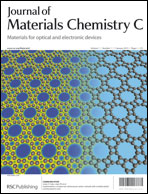Tunable negative permittivity behavior and conductor–insulator transition in dual composites prepared by selective reduction reaction
Abstract
We use a selective reduction reaction to fabricate a new kind of dual composite, which has a “composite-within-a-composite” structure. Based on the different reduction behavior of Fe2O3, an Fe-rich structure (Fe–Fe3O4–Al2O3) is formed in an Al-rich structure (FeAl2O4–Al2O3). The Fe-rich structure can bring down the concentration of free electrons to reduce the energy loss, without losing its metallic behaviour at the same time. Near the percolation threshold, a conductor–insulator transition appears and the dual composites show totally different electromagnetic responses, which can be well explained by effective medium theory. By controlling the parameters of the selective reduction process, we can get a tunable negative permittivity, which implies the ability to continuously change their electromagnetic properties.


 Please wait while we load your content...
Please wait while we load your content...